Victoria Sadler's Blog, page 8
August 6, 2015
Review: Three Days in the Country, National Theatre
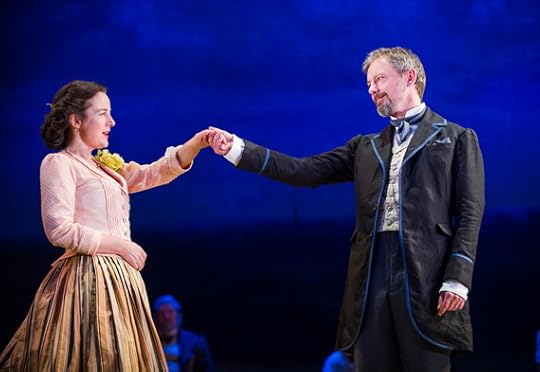
Three Days in the Country at the National Theatre is an exciting, absorbing version of Ivan Turgenev's A Month in the Country. It's smart, funny and overcomes its challenges to keep you entertained.
Turgenev's beautiful phrasing and repartee sparkle in this tragic-comedy of errors about a dashing tutor and his impact on a large Russian estate. However that the main characters in this play are not particularly likeable, or even sympathetic, is a challenge.
Natalya (Amanda Drew) is selfish and bored, and lacks the courage to rattle her cage and break out of her stifling marriage to the ever-angry rich landowner, Arkady (John Light).
As a result, she has for years tortured the lovestruck Ratkin (John Simm) who dreams of whisking her away. Natalya indulges his attentions, at times even demands them. But she has no intention of embarking on any affair.
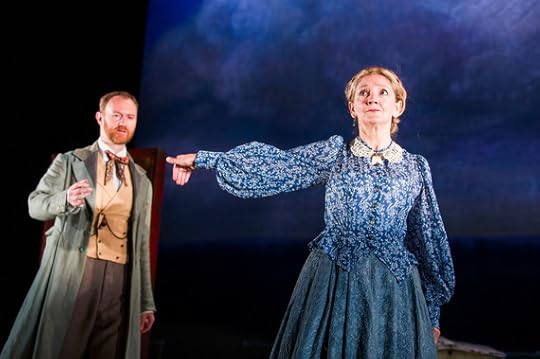
That is until the suave Belyaev (Royce Pierreson) arrives to tutor her son. Belyaev's Casanova-style behaviour sends ruffles through the women of the household, and results in Natalya squaring up to Vera (Lily Sacofsky), her ward, in order to secure Belyaev's attentions for herself.
But given that a love triangle between bitter, angry people can be quite difficult to care about, what saves this production? Its profound and well thought-out investment in the more peripheral characters.
Whether it's the terrific Mark Gatiss as the social-climbing doctor Shpigelsky, Debra Gillett as the sparky Lizaveta or Nigel Betts as the bumbling Bolshintsov, these characters become the heart and soul of the piece, injecting the show with both comedy and pathos. You feel more for them then you do for the rather damaged central characters.
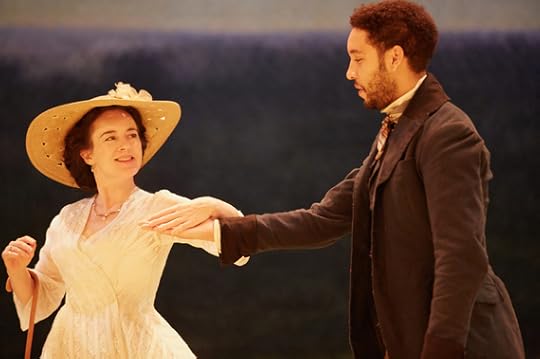
And this skew is managed by some clever directing from Patrick Marber. Scenes are kept short with quick segues from one to the next. It keeps the energy going, pushes the play forward and ensures that no matter if we are in scenes which may not be as interesting for the audience, with characters we may not particularly care for, we are never far away from a quick change-up to bring us back on board.
The bravest part of this production is its design from Mark Thompson. When the curtain lifts, the first thing that hits you is the complete absence of any set. This is a stripped back Lyttleton stage with a handful of props - a table, some chairs and maybe a couple of glasses.
Yet colour and texture infuses this bare arena through the vast painted landscape that drapes the back of the stage, and through the rich, sumptuous traditional clothing worn by all the characters. It is arresting for those expecting a lavish traditional production yet it's exciting and successfully pushes aside all the literal and metaphorical weight of a burdensome set and lets its characters roam free around the stage, giving them space to move and breathe. It injects life into the production.
Yet that is not all I noticed when the curtain lifted at the start of the show.
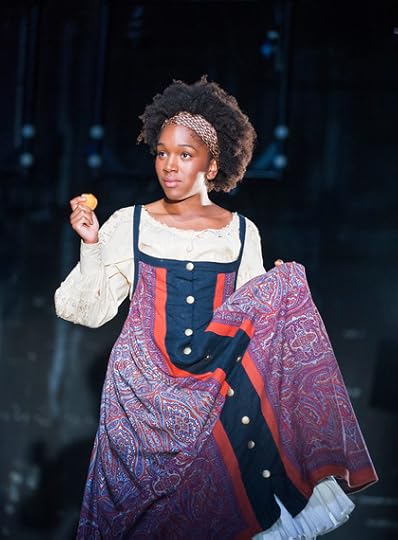
There are 20 parts in this production, about 12 of which are speaking, and only two of these are played by POC and, yes, one of them was playing the maid. I wince any and every time I see a WOC cast as a maid or servant. It's just all sorts of wrong. Just not good enough. Diversity isn't just about numbers but where those numbers are and, well, can we please just stop casting WOC as maids.
That isn't the only diversity concern. Patrick Marber has kind of taken over the stages at the National Theatre. In addition to directing and adapting Three Days, he also wrote The Red Lion, which is showing at the Dorfman, and was the dramaturg for The Beaux Stratagem, showing on the Olivier. The NT has even been promoting this seemingly great achievement on Twitter with the hashtag #PatricksHattrick
For me, that three stages out of the four available at the NT have been handed over to the same white male playwright/director doesn't exactly make me want to do cartwheels. I would have been more impressed if the opportunity had been taken to give an opportunity to a female playwright or person of colour instead.
I have written about the challenges facing female playwrights specifically elsewhere. Considering its place in theatre, the National Theatre really needs to start taking action on diversity as actions speak louder than words and from where I was sitting, it didn't look great.
National Theatre, London to October 21, 2015
Image Credits:
1.Photo credit: Tristram Kenton. Amanda Drew (Natalya) & John Simm (Rakitin) in Three Days In The Country by Patrick Marber, after Turgenev, National Theatre.
2.Photo credit: Tristram Kenton. Mark Gatiss (Shpigelsky) & Debra Gillet (Lizaveta) in Three Days In The Country by Patrick Marber, after Turgenev, National Theatre.
3.Photo credit: Mark Douet. Amanda Drew (Natalya) & Royce Pierreson (Belyaev) in Three Days In The Country by Patrick Marber, after Turgenev, National Theatre.
4.Photo credit: Tristram Kenton. Cherelle Skeete (Katya) in Three Days In The Country by Patrick Marber, after Turgenev, National Theatre.
Published on August 06, 2015 12:57
August 2, 2015
Review: Ben Whishaw Stars in 'Bakkhai', Almeida Theatre
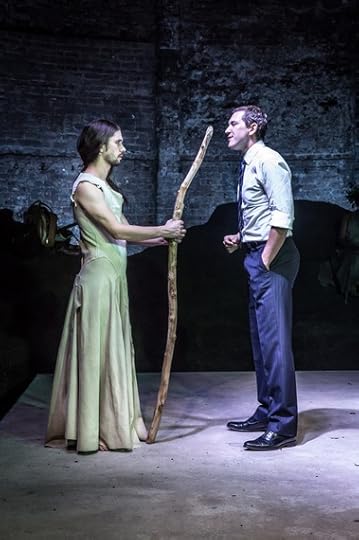
What I love most about the Almeida Theatre is the risks that it takes and, my god, its new production of the Greek tragedy, Bakkhai, is a massive, massive risk. At times it is one of the most impressive pieces of theatre I've seen; at other times it's completely insane. But one thing's for sure - I've never seen Greek tragedy done like this and it's a production that is impossible to forget.
The star draw is Ben Whishaw and, my, he oozes charisma and a beguiling erotic enticement as an effeminate and dangerous Dinoysus, the self-proclaimed God of wine, madness and ecstasy. Seductive and sensual, arrogant and manipulative, Ben's complete ease with the power in his hands blends dangerously with his wickedly, playful spirit. It's a tempting, tantalising performance.
And he is given the perfect adversary in Bertie Carvel's alpha male - the smooth-talking but ruthless Pentheus, a King so obsessed with order he has no qualms with throwing his own mother into jail for questioning his autocracy.
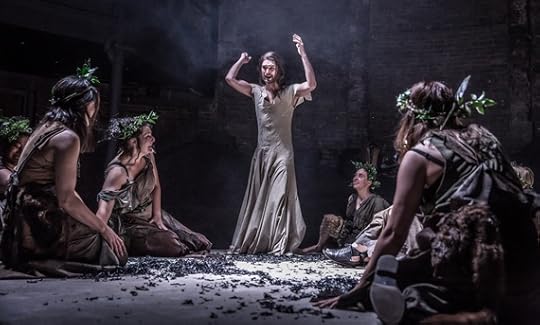
These two dictators, so similar yet so different, circle each other, adamant that only one can rule. And their battleground is Thebes, personified by the Chorus - the women, overwhelmed with fanatical devotion, who have fled Thebes for the arms of the God that walks amongst them.
Watching this power play build up to its denouement is the big hook so it's brave stuff from Director James Macdonald to stick with Euripides' intentions and give the Chorus the far greater stage time. Their chanting, swaying and almost haunting single voice both scare and serenade. It's a clever way to manipulate the pacing of the show, keeping us waiting, balancing out the tension of the main battle.
For 90 minutes this production is scintillating. The translation from Anne Carson is daring and contemporary. Its blend of dramatic text and witty colloquialism is effortless and a real highlight. The staging is superb and the acting is awesome - some of the finest performances you will see this year.
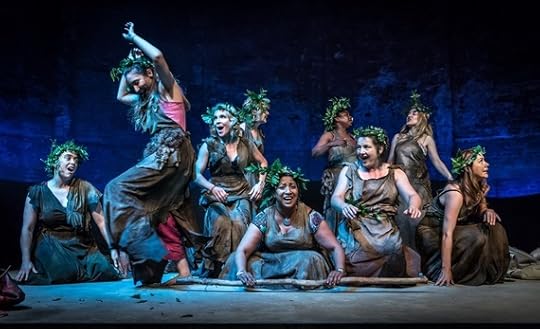
Ben Whishaw mesmerises and Bertie Carvel is incisive and brilliant. But special mention must also go to the magnificent Kevin Harvey, who excels in a myriad of supporting roles, and the women of the Chorus who captivate completely.
But then Bakkhai descends into complete madness and the whole production just goes... well, for a while I didn't know where it was going. The great battle between these two men never materialises, Pentheus too easily outwitted. Ben Whishaw, shorn of the long locks of Dionysus, scampers onto the stage as (seemingly) another character, the Chorus whip themselves into an unbridled frenzy - stamping and shrieking as if possessed - and Bertie Carvel takes to the stage as some mad, dragged-up version of Gaga cradling a decapitated head - his own.
It's at this point that you just think - what? What happened?? Why has everyone gone completely mad?
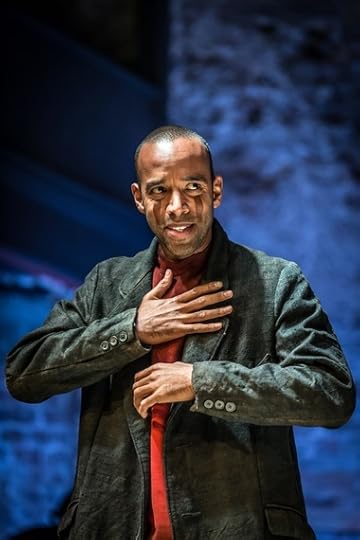
But hang with this, hang in there. Because it's incredibly brave that James Macdonald chooses not to take his foot of the brakes here. If you are going to depict hysteria, you've got to commit to it 100% and that is exactly what this production does.
Because it is this madness, this religious fervour and the destruction and havoc that it can wreak that is the central subject in Euripides' writing - not the power play. What is the difference between the gods and men? If gods are as vengeful and bloodthirsty as men then we should not worship them. Blood lust is not godly and should not be craved. Madness is dangerous. Religion and violence should never go hand in hand.
Bakkhai is a stunning production - and it is a production that stuns. It may well end up being one of the most divisive productions of the year - some will give it five stars, others will come out dazed and confused. But either way, this production will stay with you and, given the time to take it all in, slowly you realise you have witnessed a truly original piece of staging. Brave and quite brilliant. May theatre never stop taking risks.
Almeida Theatre, London to September 19, 2015
Image Credits:
1.Ben Whishaw and Bertie Carvel in Bakkhai. Almeida Theatre. Credit Marc Brenner
2.Ben Whishaw and cast of Bakkhai. Almeida Theatre. Credit Marc Brenner
3.Cast of Bakkhai. Almeida Theatre. Credit Marc Brenner
4.Kevin Harvey in Bakkhai. Almeida Theatre. Credit Marc Brenner
Published on August 02, 2015 11:48
July 30, 2015
Review: The Beaux Stratagem, National Theatre "Its Fun is Infectious"
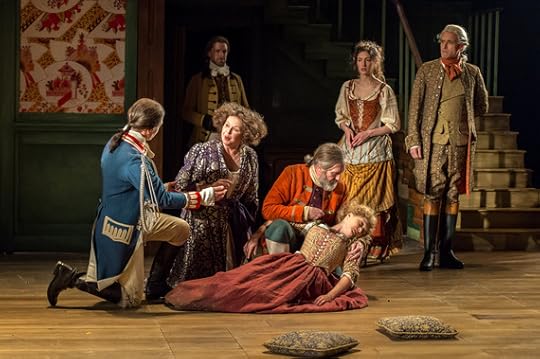
I so wanted to be cynical about The Beaux Stratagem but it is just impossible. Its sense of fun is infectious and if you don't find yourself laughing and smiling, well, you're probably dead.
Aimwell (Samuel Barnett) and Archer (Geoffrey Streatfeild) are two opportunists, two charming but devious young men who've blown their fortunes in London, and who've come to Lichfield with the great idea of swindling a local beautiful heiress out of her fortune - pretend to love her and live off her income for years!
What a great idea. What could possibly POSSIBLY go wrong?
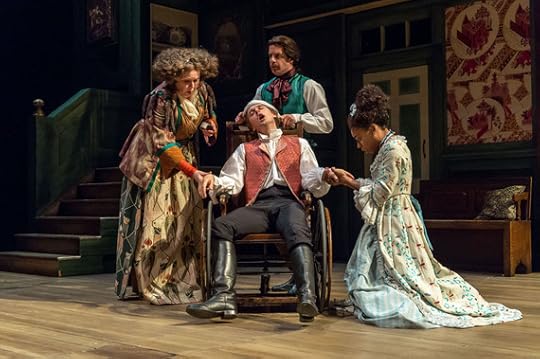
So they pose as man and servant at the local inn, engaging the innkeeper (Lloyd Hutchinson) and his daughter (Amy Morgan), with hints of a secret life and access to vast sums of money.
But the naïve heiress Aimwell has his cruel heart set on is Dorinda (Pippa Bennett-Warner) only she is protected by her feisty, streetwise sister-in-law (the ever impressive Susannah Fielding) and what started off as a simple plan soon starts to unravel.
Of course it does! And of course we all know where this will end up. Everyone will fall in love - in spite of themselves - and we'll all wind up with a big song and dance number to send us on our way. We know this. WE KNOW THIS. But we don't care. Why? Because the journey is just so, so good.
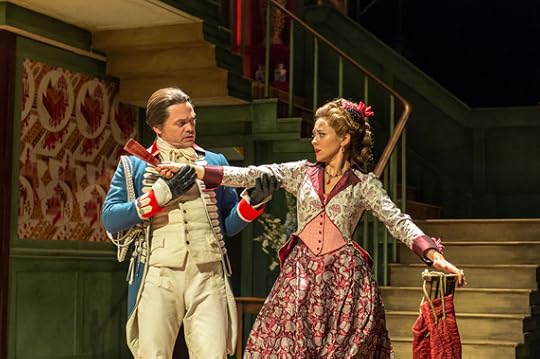
The cast are energetic and enthusiastic, throwing themselves into their clichés with gusto, whether it's the tavern wench trying to make good, the savvy and scheming wealthy woman from London, or the moping French Count pouring his deep and profound emotions into every word and interaction.
And it was that which worried me - could I withstand a Restoration Comedy without judging it through my modern, feminist eyes? How many mother-in-law jokes could I take? How many saucy Carry On-esque nods and winks could I sit through?
But I needn't have feared as, much like George Farquhar's other play, The Recruiting Officer, which was brilliantly revived recently at the Donmar, the myriad of overlapping plots and stories keep the mind engaged and the combined efforts of the cast and creative team enable this production to navigate quite nimbly around the more tricky parts of this 300 year old play.
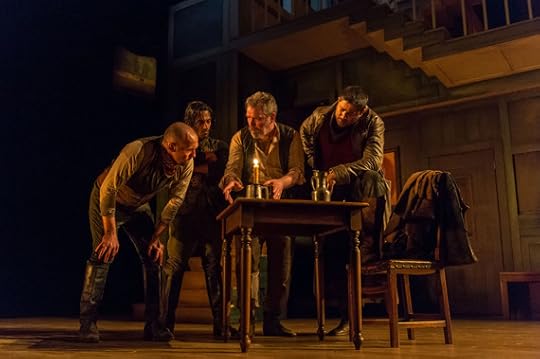
The direction from Simon Godwin is glorious. Music and dance numbers are effortlessly segued in, often preluded with a nod and a wink. The writing is mined for all the humour it's worth, and the pacing is superb with moments of high farce blended with corny but sweet declarations of love.
You can fight it all you want, people, but resistance is futile. The Beaux Stratagem will lift you up and make you smile.
National Theatre, London to September 20, 2015
Image Credits:
1.Timothy Watson, Jane Booker, Pearce Quigley, Amy Morgan, Molly Gromadzki and Nicholas Khan, The Beaux' Stratagem © Manuel Harlan
2.Jane Booker (Lady Bountiful), Samuel Barnett (Aimwell), Geoffrey Streatfeild (Archer) and Pippa Bennett-Warner (Dorinda), The Beaux' Stratagem, © Manuel Harlan
3.Timothy Watson (Count Bellair) and Susannah Fielding (Mrs Sullen), The Beaux' Stratagem ©Manuel Harlan
4.Mark Rose (Hounslow), Esh Alladi (Bagshot), Lloyd Hutchinson (Boniface) and Chook Sibtain (Gibbet), The Beaux' Stratagem © Manuel Harlan
Published on July 30, 2015 14:49
July 27, 2015
Review: Carsten H��ller: Decisions, Hayward Gallery

Art is usually a passive experience - you observe paintings, sculpture, photography or video, take in what is in front of you and make a judgment based on a whole raft of personal reasons - both conscious and subconscious. What Carsten Holler's new exhibition at Hayward Gallery provokes is when you become part of the exhibition, and how your explicit actions and decisions shape your experience.
This major exhibition - Carsten Höller: Decisions - presents a wide range of Carsten's works from new creations, such as Isomeric Slides and Two Flying Machines, to early artworks, such as The Pinocchio Effect (1994) and Upside Down Goggles (1994-1009). And the variety of the works is impressive, from site-specific installations to videos, from kinetic sculptures to lightworks.
And almost all of the pieces demand interaction from the visitor. You can push the Flying Mushrooms sculpture round and round, and watch the distinctive red mushrooms whirl and swirl above you. And, if you're lucky enough to be a child, you can clamber into Dice and roam around inside this, well, playcentre.
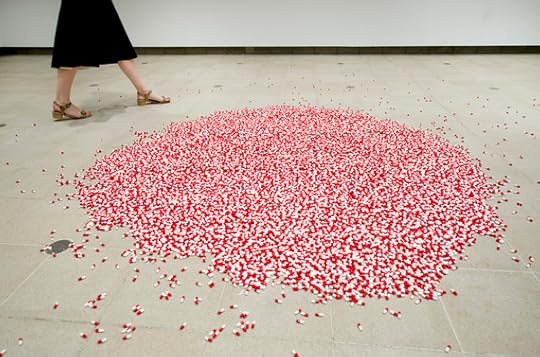
And there are decisions to make too. Do you want to walk through the pitch-black corridors of Decision Corridors? And do you choose to swallow the unmarked tablets in Pill Clock?
Carsten Höller considers the visitor's presence a key part of his work, that his pieces are not in isolation from them. And making our decisions isn't meant to be straightforward. Carsten calls this 'active uncertainty.' And this is echoed by the curator of the exhibition, Ralph Rugoff, who wants to explore "a frame of mind conducive to entertaining new possibilities."
The sense of fun and excitement is palpable, especially around the big draw theme-park-esque rides such as the flying machines and the slides. The queue alone for Upside Down Goggles was over 30 minutes long, too long for me to queue and have a go. But it was certainly intriguing watching participants put on the goggles, which invert the world around you, and struggle to even take one step forward.
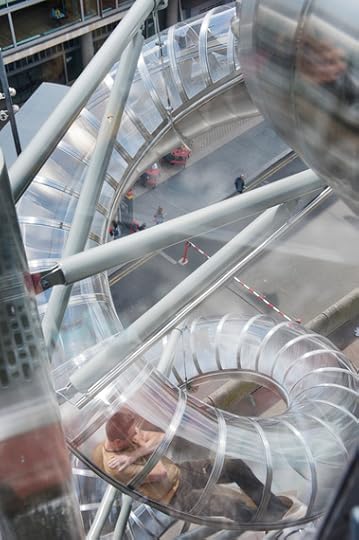
The act of observation is supposed to be part of the experience, and one that I probably wasn't that comfortable with (which may indeed be the point). To gawp at others isn't art to me, nor is it particularly polite, but it is revealing.
There is a viewing window out over Two Flying Machines, where participants lined up in their droves to be strapped into paragliders fixed to a carousel. Once in, the visitors went round and round, as if flying over the streets of London below them.
The participants are allowed to take their mobile phones on to the machines with them and it was fascinating how many felt the need not just to record the experience, but then, evidently, send it out on social media whilst they were still strapped to the machine.
This observation led to many barbed comments around me on mobile phone addiction. This was particularly true as we watched one woman more focused on reading her text messages and tweeting out her photos than actually being present in the experience and enjoying the view over London.
Maybe there is something in this 'art is experience' thing after all.
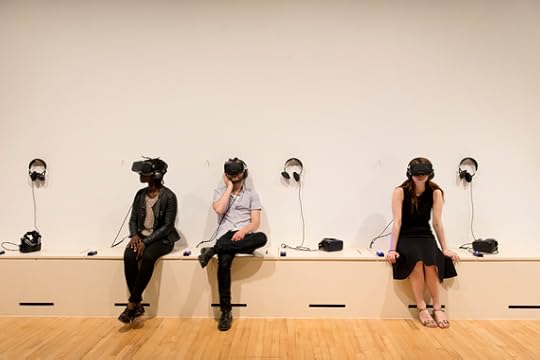
It's not a surprise that these fun participatory exhibits are the most popular. At times it did feel like I was in a theme park or even the Science Museum, where people are encouraged to test devices that influence proprioception (how our brain imagines changes to parts of our body when certain muscles are stimulated), as in The Pinocchio Effect, or wear 3D headsets to transport themselves to a winter forest, as in The Forests.
Decision-making isn't the only theme in the exhibition. The subject of twins, doubles, also runs through many of the pieces - there are two slides and two flying machines, two robotic hospital beds roaming the ground floor of the gallery, even two day-glo pink polystyrene snakes.
Though there's evidence all around of this interest in replication, in copies, I'm not sure that this message really hit home.
The large upper gallery has vast ceiling-to-floor mirrors on its walls. This is actually a piece of work, Half Mirror Room, and, per the exhibition guide, "offer(s) a glimpse of what we look like to the rest of the world." What, like how an actual mirror does all the time? Is putting up a mirror now art?
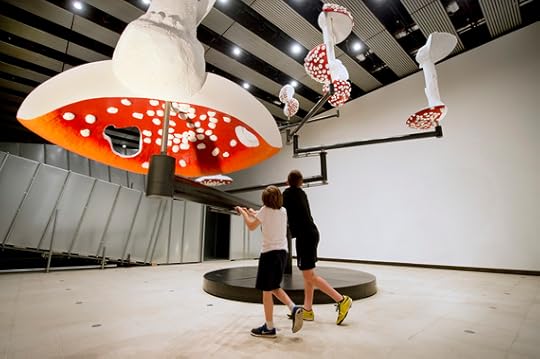
Also in the upper gallery there is an actual piece called Twins. A piece that takes over a slim corridor. Two rows of TV screens are on either side and from each screen, a twin sings or speaks contradictory sentences at their own twin who is on the screen on the other side. Interesting but it was telling how many passed straight through, more interested in getting to the slides.
Is all of this this art? I don't know. Did it challenge my preconceptions of myself and / or society? Well, I was aware of my reaction to each piece - my refusal to go into the darkness of Decision Corridors for fear of claustrophobia, or the fact that I stood at Pill Clock for an age, obsessively counting the seconds between every pill dropping on to the pile, and wondering why anyone would pick up a pill from the floor of the Hayward Gallery and swallow it.
These acts in themselves revealed something about me. It caused a reaction. But then everything in life causes a reaction. I have an emotional reaction every morning during rush hour on the Tube but that doesn't make my commute art.
Or does it? I don't know anymore. And I guess that was the most fascinating part of this exhibition - that I have no clue whether any of this constitutes art. Is a slide art? Probably not. But I still went on it anyway because I knew it would be fun.
Hayward Gallery, London to September 6, 2015
Image Credits:
1.Carsten Ho��ller, Two Flying Machines, 2015 © Carsten Ho��ller. Installation View Carsten Ho��ller l Decision, Hayward Gallery
2.Carsten Ho��ller, Pill Clock 2011_2015 © Carsten Ho��ller. Installation View Carsten Ho��ller l Decision, Hayward Gallery
3.Carsten Ho��ller, Isomeric Slides, 2015 © Carsten Ho��ller. Installation View Carsten Ho��ller l Decision, Hayward Gallery
4.Carsten Ho��ller, The Forests, 2002_2015 © Carsten Ho��ller. Installation View Carsten Ho��ller l Decision, Hayward Gallery
5.Carsten Ho��ller, Flying Mushrooms, 2015 © Carsten Ho��ller. Installation View Carsten Ho��ller l Decision, Hayward Gallery
Published on July 27, 2015 11:44
July 23, 2015
Dynamic Exhibition on The Jam at Somerset House
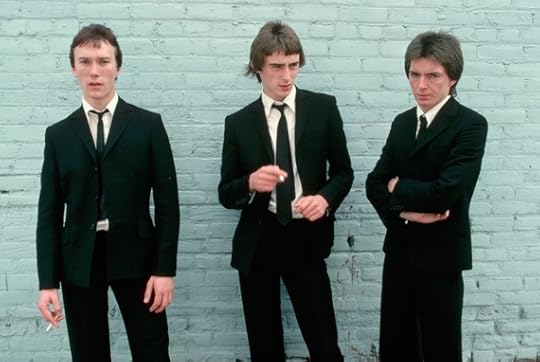
Somerset House has opened the first comprehensive exhibition about The Jam, the iconic band who not only had 18 consecutive UK top 40 singles and over 14 million global album sales, but who also immortalised life for many of Britain's disenchanted youth during the late 1970s and early 1980s through their music and lyrics.
The Jam: About the Young Idea, to give this show its full title, has been curated by Paul Weller's sister, Nicky, who also ran the band's fan club (a position, the exhibition explains, was rather put upon her, at the time, as the band became overwhelmed with fan mail).
Nicky though has pulled together a terrific exhibition; a result from unprecedented access to both the band's and fan archives. For the very first time, all three members of the band - Paul Weller, Rick Buckler and Bruce Foxton - the Weller family and music archivist Den Davis have agreed to open up their collections and the result is fantastic.
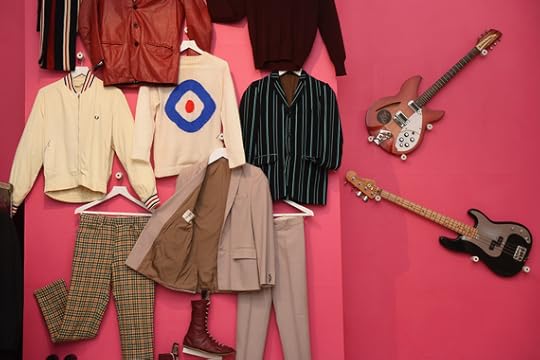
Live concert footage runs on loop, music blaring out across rooms filled with some of the band's jackets, vintage concert fly posters and an impressive display of the band's guitars (a particularly touching one being Paul's fireglow Rickenbacker 330 with 'I Am Nobody' scratched into it).
There are also the band's vinyl releases, tour merchandise, concert reviews (including one written by a certain Neil Tennant of their last show at Wembley Arena) and an interview with Paul especially recorded for the exhibition.
The effort that has been put into curating this exhibition is exciting but it is its emotional impact that is most impressive. You really get under the skin of the band, walk in their shoes and see the world they grew up in through their eyes.
I can't deny that this exhibition held a certain draw for me in that Woking is my hometown, and Woking was, of course, the birthplace of The Jam. Prior to The Jam, nothing impressive ever came out of Woking. It was a dead-end suburb, a stop-off on the main train line from London.
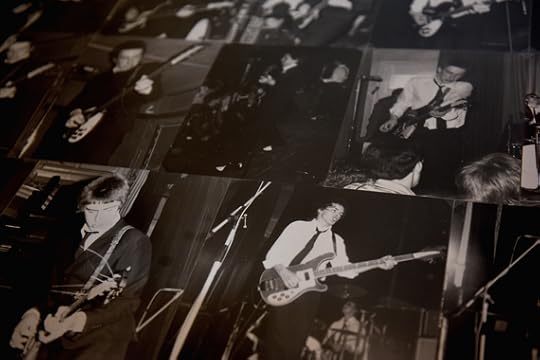
In the 1970s the town was a scene of much social strife caused by the economic recession. An increasingly disgruntled working class governed by an insanely wealthy and very right-wing Tory MP (Woking remains one of the safest Tory seats in the House) was not a great combination and from this agitation, The Jam was born.
That world of 1970s Woking, of Stanley Road, Sheerwater Secondary School and working men's clubs, is vividly brought to life with a wonderful array of black and white photos, vintage street maps, and old copies of the Woking News and Mail.
This was very much a moment in time. So much of the Woking you see in the photographs and in the paper cuttings has been bulldozed away, covered with cement and replaced with Paperchases, Café Rouges, and a Wetherspoons, a fact emphasised by a video tour of the town today running on loop in one of the galleries.
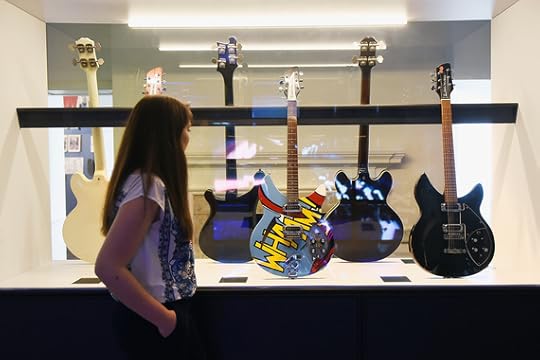
In the early days there was a lot of fluctuation in the band's line-up and the early photos brought together include Steve Brookes, Neil Harris and Dave Waller before they left to go their own ways. Through these photos, handwritten lyrics and stage suits, the show demonstrates how the band developed its settled line-up and its distinct image.
The politicisation of the British music industry in the 1970s and early 1980s was profound, with punk music very much at the fore so The Jam, with their sharp suits, stylised Mod image and well-crafted music found themselves criticised by many in the punk scene who craved anarchy.
Yet The Jam found their niche and their fans, though it was only a brief moment in the sun as the band suddenly split in 1982, at the height of their popularity. But as this exhibition proves, The Jam shone very brightly in those few years.
Yes, this exhibition will delight the hardcore fans - the memorabilia and exhibits are superb - but this is also a fantastic study in the rise and development of one of the most influential bands in British music history. A powerfully evocative exhibition that any music enthusiast will enjoy.
Somerset House, London to August 31, 2015
Image Credits:
1.Photo © Neal Preston Corbis, Members of The Jam
2, 3, 4. Installation images © Mary Turner/Getty Images for Somerset House
Published on July 23, 2015 16:00
July 20, 2015
Ballet Review: Natalia Osipova Wows at the Ardani 25 Dance Gala
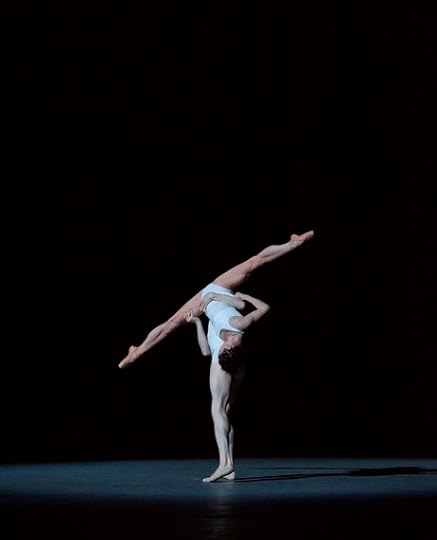
There is a reason why Natalia Osipova is the dancer everyone wants to see. And the star delivered on her box office draw for the Ardani 25 Dance Gala with performances full of her trademark visceral, emotional intensity blended with impressive technical excellence.
The star delivers, yes, but she is enabled by a programme of works that not just excite and challenge, but also by a cast of incredibly impressive male dancers.
The first piece, Zeitgeist, sees Natalia partnered with Edward Watson for a dark, sensual performance to a haunting violin concerto from Philip Glass. The performance was a World Premiere and my god, it delivers.
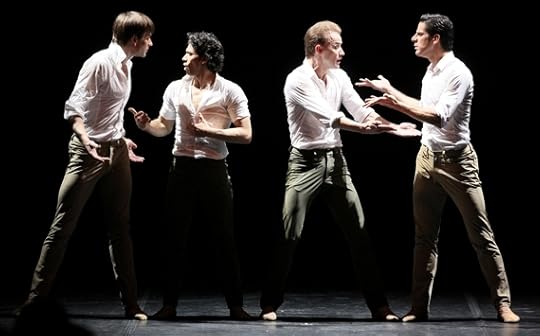
Natalia's performance of an intense and dangerous femme fatale was just infused with sensuality. Her pas-de-deux with Edward Watson took my breath away. The choreography from Alastair Marriott is exciting and fresh with demanding leaps and turns mixed in with contemporary dance but the story of a woman playing, manipulating those around her never dropped for a second.
The piece was so deliciously dangerous that it was a smart move to follow such intensity with the joyful, playful Tristesse. Choreographed by dancer Marcelo Gomes, who also performs, it's a bright, witty showcase for its four male dancers - Marcelo, Joaquín de Luz, Friedmann Vogel and Denis Matvienko.
The final piece in this programme of works, Facada, was the most intriguing. Full of light and shade, joy and death.
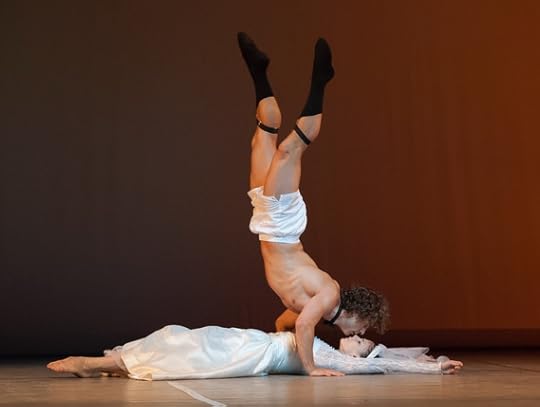
Natalia Osipova returns, this time as a bride anticipating the imminent arrival of her soon-to-be husband, played by Ivan Vasiliev. But the groom does a runner and what starts off as a light-hearted piece descends into an explosive and murderous drama as the jilted bride tracks down and kills the man who left her standing.
The music is a passionate Portuguese fado, played live by composer Frank Moon, and it's a terrific musical composition that brings out all the hope and joy of a bride on her wedding day only for the tone to plummet dramatically into an intense score with agitated strings and thundering drum beats.
Natalia and Ivan are both superb. Ivan's grace and athleticism impress and make for an interesting comparison with his partner - how great to see the female role with the responsibility for the power and violence.
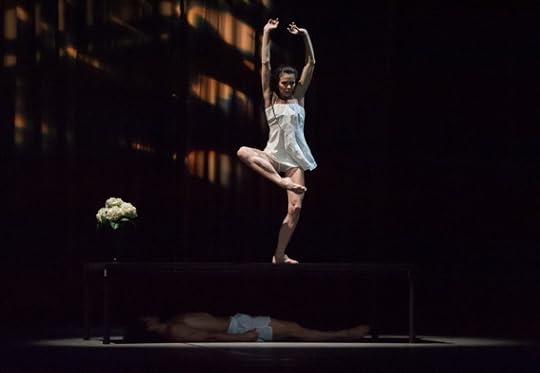
The choreography from Arthur Pita is angry and animalistic as much as it is technically demanding and even graceful. And he adapted the piece especially for the two dancers and, wow, do they deliver.
My enduring memory of the Ardani 25 Gala will be Natalia Osipova dancing, ferocious and primal, on the grave of the husband-to-be she murdered. A Fury whose vengeance is complete. Stunning, terrifying, iconic.
And such a memory is only appropriate for what is an impressive evening of works, superb choreography and exciting musical compositions that have been brought together for the Ardani 25 Dance Gala. If only all Gala evenings could be like this.
Image Credits:
1.Natalia Osipova and Edward Watson in Zeitgeist © Andrej Uspenski
2.l-r Friedemann Vogel Herman Cornejo Denis Matvienko and Marcelo Gomes in Tristesse © Stas Levshin
3.Natalia Osipova and Ivan Vasiliev in Facada © Doug Gifford
4.Natalia Osipova and Ivan Vasiliev in Facada © Doug Gifford
Published on July 20, 2015 16:27
July 13, 2015
Theatre Review, High Society, Old Vic Theatre 'Wonderful'
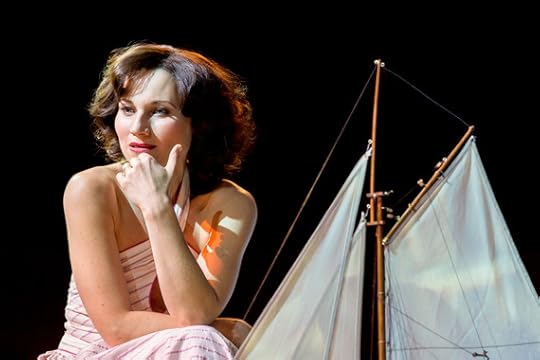
Oh, High Society at the Old Vic is a definite winner. Cole Porter's score is great, of course, and the book witty but sometimes taking on the classics is perilous. But this production is a success. The show is full of charm, characters are strong and the set design is ingenious.
Whether it's The Philadelphia Story or High Society, the story from Arthur Kopit remains as engaging as ever. Socialite Tracy Lord (played with real punch and panache by Kate Fleetwood) is planning her summer wedding. Her second. Only her fiancé, the rather dull and dreary George Kittredge (a great performance from Richard Grieve) isn't her only suitor.
Her dashing ex-husband, charmer Dexter Haven (played with real debonair flare by Rupert Young) is back in town, desperately wanting to win back the women he lost. And then there's Mike Connor (Jamie Parker), the roguish journalist sent undercover to report on the wedding, who ends up falling for the woman at the centre of his story.
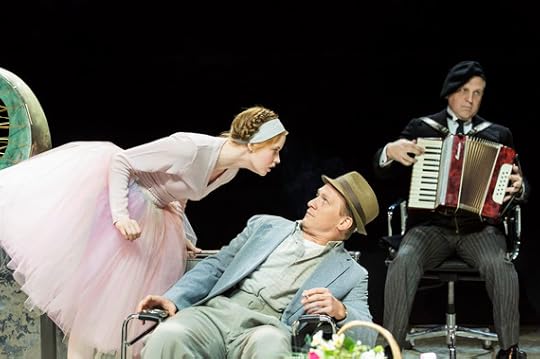
I could say, who will it be? Who will Tracy end up with? Who will she choose? But really, even if you don't know the story, it's a no-brainer. This is a musical with a feel-good factor, a happy ending. True love will win out!
But this isn't a sickly, insipid love story. Not at all. The characters are all kept bold, just teetering on the edge of being over-the-top. It's brilliant stuff, all adding to the high stakes, emotional rollercoaster ride. Each performance is excellent - though all are very nearly outshone by a brilliantly pitched comic turn from Ellie Bamber as Tracy's unpredictable and rather spoilt younger sister, Dinah.
There's a terrific energy throughout the show, sustained by a superb ensemble who work tirelessly as the bustling household staff, and a great live orchestra who serve up the Cole Porter classics beautifully - Well, Did You Evah!, Who Wants to be a Millionaire?, True Love... Each of them faithfully delivered.
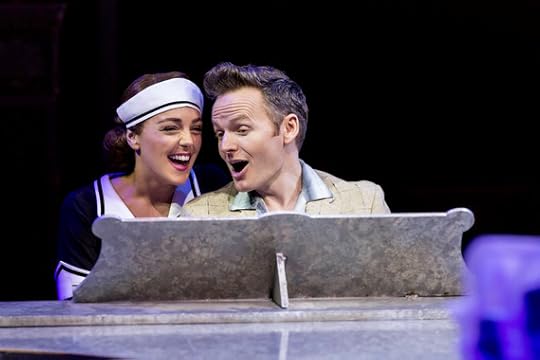
The Old Vic remains set in the round, as it has been for just over a year now. This must have been a phenomenal challenge to director Maria Friedman and her production design team, headed by Tom Pye. Just the thought of it... How on earth can you convey the sumptuous, extravagant lives of the idle rich of Long Island in such a limited space?
Well, to give too much away would be a shame but what ingenious solutions the creative team has come up with. Almost every scene change came with audible gasps from the crowd and smatterings of applause. A definite round of applause from me just for the set design alone.
I really enjoyed this production. Just one small hitch though. The night I went I took my mother with me and Lordy, she wouldn't stop singing along for the duration of the show. For this, I can only apologise to all those sitting near us. But hey, that's the power of High Society for you and the effect that this show has - you just can't help getting swept along. Wonderful.
Old Vic Theatre, London to August 22, 2015
Image Credits:
1.Kate Fleetwood, High Society, Old Vic Theatre. Photo by Johan Persson
2.Ellie Bamber and Jamie Parker, High Society, Old Vic Theatre. Photo by Johan Persson
3.Philippa Stefani and Joe Stilgoe, High Society, Old Vic Theatre. Photo by Johan Persson
Published on July 13, 2015 11:29
July 9, 2015
Ballet Review: Christopher Wheeldon Casts a Spell with Cinderella
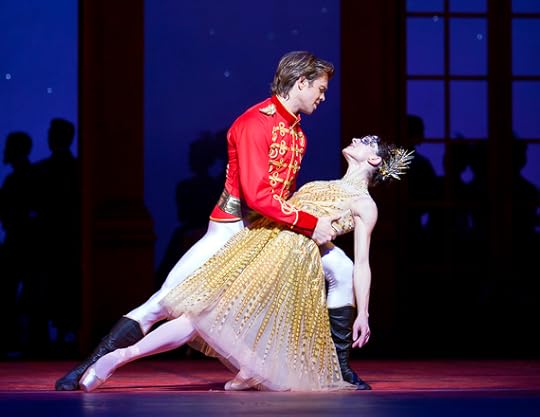
For most of us, Cinderella is a tired fairy-tale yet this classic story has been given a stunning new lease of life in a spellbinding reimagining from Christopher Wheeldon that bewitches you with its charm, its magic and its captivating dark undertones.
Presented by Sadler's Wells, where he is an Associate Artist, Christopher has collaborated with the Dutch National Ballet to create this imaginative reworking. For this is no rerun of the typical Cinderella story. Instead, this Cinderella is based on the version from the Brothers Grimm, rather than the traditional fairy-tale from Charles Perrault.
So the Fairy Godmother is out, along with her pumpkin coaches and friendly mice, to be replaced with a dead mother, a weak (and remarried) father, and a host of magical spirits that protect the young Cinderella as she makes her way through her challenging new life.
And from this version, Christopher has created a ballet that is ethereal and otherworldly, sometimes slightly sinister and occasionally almost gothic in its appearance. It is utterly captivating.
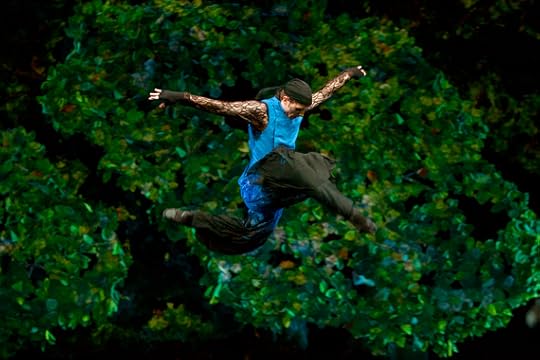
With change of course comes challenge and there are a few missteps along the way. For example, we're more used to the big meet between the Prince and Cinderella coming at the Ball, but this isn't what happens here.
Instead, whilst playing a game of high-jinks with his friend, the Prince, disguised as a pauper, happens upon Cinderella who treats him kindly. Yet all this happens in the corner of the stage with the main focus supposedly being on the Prince's friend who is performing a comedic piece with Cinderella's two step-sisters who have mistaken him for the Prince.
It's all distracting and confusing. When Cinderella meets the Prince, that should be the show-stopper. Instead we have two scenes going on at once, and the principal one reduced to a sub-story, which waters down the excitement of their first meet.
It didn't really work but as the ballet enters the second Act, it leaves these troubles behind and the focused narrative of Cinderella, the ball and the lost slipper returns, the storyline gains its focus and its narrative drive and the show really finds its stride.
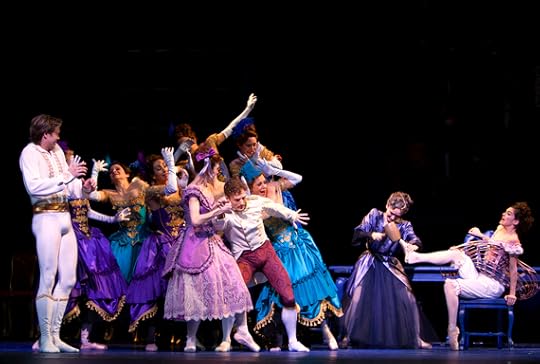
Thankfully, the show never loses its dark, romantic spirit. Prokofiev's jubilant score remains but as we watch Cinderella and the Prince bond and romance through increasingly intimate pas de deux, this feels very much like a meeting of broken hearts - two people burdened by their unhappy circumstance - finally finding someone who understands them. Christopher's ability to pull this emotion from the score is impressive and you are completely drawn in.
And this is emphasised with two excellent lead performances.
Anna Tsygankova makes for a wonderfully delicate Cinderella. There is a fragility to her spirit and a hesitancy that intrigues. This isn't a starry performance full of smiles and grand gestures but one of a young woman still mourning the loss of her dead mother and trying to find inner confidence. Anna's ability to blend this sentiment with her excellent ballet performance is most impressive.
Anna's Cinderella is regularly shadowed by the four Fates, the spirits that have protected her since her mother's death, and their movement together is, for me, the highlight in the production. You feel the weight of Cinderella's reliance on them and yet the rush, the strength and the grace they bring to her when they are near.
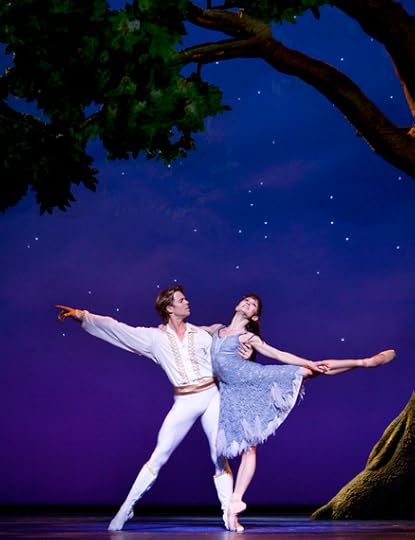
Matthew Goulding as the Prince is very much the star draw. He's just got it all - a superb actor as well as a wonderful ballet dancer. And throw his charisma and good looks into the mix and he makes for the perfect Prince. His performance is full of expression and his dancing a wonderful blend of power and poise. Perhaps his skills are under-utilised in the role but nevertheless, his performance is excellent.
Christopher Wheeldon's choreography is at its best for the full corps de ballet. The group scenes are superb and the fluidity is mesmerising, with the dancers ebbing and flowing like tides to emote the presence of magic and emotional surges. It is fresh, emotive and it just sweeps you up.
And this enthralling choreography is enhanced by the production design of this show which is, quite simply, out of this world. It's a stunning series of sets and visual design from Julian Crouch , which varies from the richly decorated sumptuous balls and jewelled dresses, to the more creepy magical spirits with giant bird heads.
The emotional impact in this reinterpretation is profound. The darkness, the magic of twilight and spirits is such a fresh and challenging change from the more common - and more saccharine - version of Cinderella we are more familiar with it. I hope I get to see it again.
London Coliseum, until July 11, 2015
All Images: Dutch National Ballet, Cinderella. Photos by Angela Stirling.
Published on July 09, 2015 12:32
July 6, 2015
Rory Kinnear Stars in a Bizarre Adaptation of 'The Trial', Young Vic Theatre
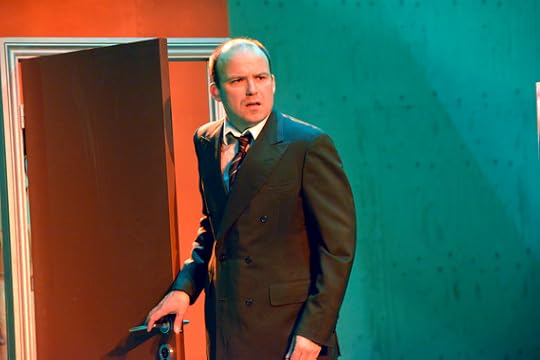
It really pains me to say that, despite the best efforts of the magnificent Rory Kinnear, The Trial at the Young Vic is not one to remember.
Kafka's classic novel on guilt, authority and injustice has been reworked into a bizarre time-shifting comedy-drama, ripping all soul and emotional punch from the piece. Even the language is obscure, with contemporary dialogue fragmented with monologues in broken German-English.
Rory Kinnear is Josef, the unlikeable, brash anti-hero of the play who wakes up on his 35th birthday to find that he has been arrested for a crime. Only he is not allowed to know the details of the alleged crime or the specifics of his impending trial. Instead he finds his life overrun by odd members of the secret police who rummage through his possessions, steal his clothes and infiltrate his workplace.
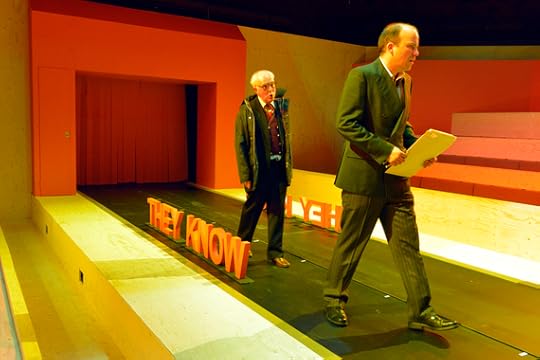
Bewildered, Josef then starts a run through the shady world of unfathomable State authority and the personalities who feed of it, in an increasingly desperate attempt to either prove his innocence or reconcile himself with his guilt.
This constant movement, this unavoidable journey to a fate that is already sealed the moment he is accused, is visually demonstrated by a travellator that comprises the stage. Sets pass by like items on a conveyor belt as Josef keeps moving on through his life, and through the worlds he enters and leaves. The audience is filed in on either side of this travellator in long benches - like jurors weighing up the guilt of the accused.
Sounds good so far but from here on in, it gets really confusing.
The production design from Miriam Buether, I sense, is an attempt at a timeless setting but it all became a bit of a mish-mash. The lawyer who takes on Josef's case is situated in the late 1960s / early 1970s with her A-line skirts, chintzy ceramic dogs and her erstwhile Nana Mouskouri-esque best friend.
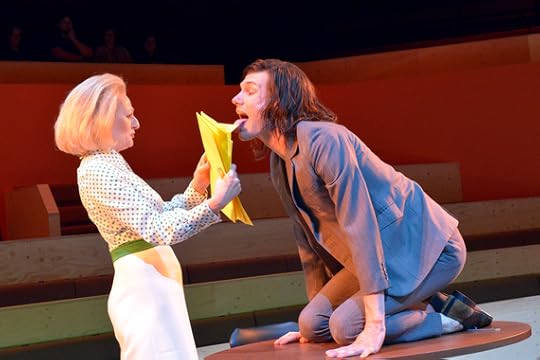
But her assistant listens to Bananarama, Josef's colleagues at the Bank are all in sharp modern suits and the artist that Josef makes his final roll of the dice with is some kind of camped-up Andy Warhol cliché. The pop culture references are all over the place and instead of making the production interestingly elusive, it just makes the piece impossible to get a handle on.
Usually I applaud risks taken but I simply don't understand any of the creative decisions in this production. Director Richard Jones' decision to mix moments of farcical comedy and curious language with surreal passages just alienates the audience and dilutes the power of this classic story. Instead of anger at authority and injustice, we, the audience, just feel limp and desperate for the end.
Too quickly the piece becomes episodic, the quirky characters Josef encounters are one-dimensional and uninteresting, and the stakes don't ever seem as if they are getting any higher. It's just the monotonous journey. In that way, the flat conveyor belt seems appropriate - never going up or going down. Just endlessly running on in one flat line.
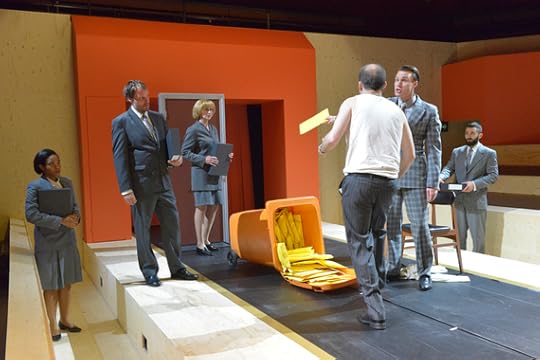
There's no interval in this two hour show yet even that didn't prevent some in the audience from leaving whilst the actors were still on the stage.
Towards the climax of the play, as I watched the events unfold with minimal interest or emotional involvement, I felt bad for Rory Kinnear as his talent stands out a mile yet not even he can save this production.
And he does try. His monologues towards the end start having some punch, as Josef realises that the seemingly insignificant events of his life are actually loaded with guilt and shame. But it's too late and the language in the adaption from Nick Gill still obfuscates. A missed opportunity.
Young Vic Theatre, London to August 22, 2015
Image Credits:
1.Rory Kinnear as Josef K in The Trial at the Young Vic. Photo by Keith Pattison.
2.Steven Beard as Uncle Albert and Rory Kinnear as Josef K in The Trial at the Young Vic. Photo by Keith Pattison.
3.Sian Thomas as Mrs Grace and Hugh Skinner as Block in The Trial at the Young Vic. Photo by Keith Pattison.
4.The company of The Trial at the Young Vic. Photo by Keith Pattison.
Published on July 06, 2015 11:34
July 1, 2015
Increasing Opportunities for Girls and Young Women on Stage
Like so many other walks of life, there is a profound gender imbalance in theatre, whether that's in the commissioning of female playwrights, female directors, or the amount of parts available to women, which in turn results in gender imbalance in casting too.
But Tonic Theatre has stepped forward with a fascinating, and hopefully incredibly effective, way of addressing some of these issues right at the start.
Tonic Theatre was created in 2011 with an aim to support theatre in achieving greater gender equality in its workforces and repertoires and now they have created Platform, a new initiative that seeks to tackle the same issue from the grassroots level of youth drama.
Platform's specific objective is to increase opportunities for girls and young women on the stage, and this came about as a response to Tonic's own nationwide research into opportunities for girls in youth drama.
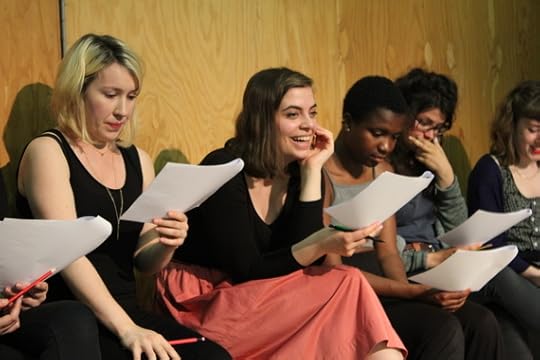
This research found that though the majority of those interested in drama at a young age were girls, the majority of roles in the scripts available to them were mostly male. Sound familiar? Ladies, how many times were you playing male characters during play readings at school? Exactly.
And it's not just the lack of numbers of female parts either. As Lucy Kerbel, director of Tonic Theatre herself observed, quality and variety is also an issue. "Speaking to young women across the country who take part in drama, the overwhelming consensus was that they found that existing writing for female characters was frustratingly narrow and often displayed outdated stereotypes of femininity. Girls overwhelmingly felt they had little opportunity to drive the action on stage, rather than being at the periphery. Some felt the only way to access complex, well-written, and demanding roles was by playing male characters."
That Tonic's own research evidenced a clear lack of provision for girls and young women taking part in drama at school, college, and youth theatre level is worrying enough. But the research suggested that this then sows the seeds for persistent gender imbalances in the theatre profession because young people enter the industry already anticipating that female characters will have less to say and less to do on stage.
So Tonic said, enough!
And in the first stage of their new initiative, they commissioned three playwrights - Jemma Kennedy, Joel Horwood and Silva Semerciyan - to write high-quality, big-cast plays for performance by school, college and youth theatre groups, which have all-female or mainly female casts.
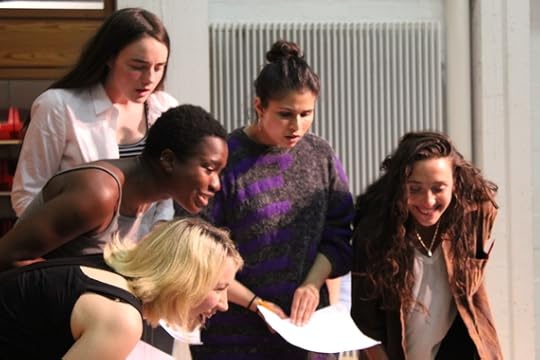
Playwright Jemma Kennedy loved the challenge the project brought. "Drama is powerful. It's a place you go to to interrogate experience but these girls too often found that the plays they read didn't relate to who they are."
And this work rewards the writer too as the girls and young women using these plays will be from across the country, from a wide variety of backgrounds, and hopefully they will now find something in these texts that relates to them, that speaks to them. As Jemma said, "To create a piece of drama to entertain is great but to create one with an emotional, social use and purpose is just fantastic."
Lucy wants the plays to make a change. "The hope is that this changes expectations [for the young girls]. By working with plays that reflect your feelings and life, it validates you, that your experience is important enough to be the subject of a play."
Creating plays with a variety of roles and, importantly, placing female characters as the propelling force in the narrative, is an important subliminal message for girls and young women, especially when the material is of a subject that they can relate to.
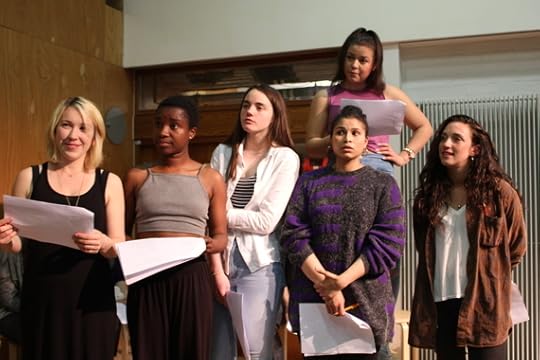
And the response from the girls and young women who've workshopped these plays has been terrific. Lucy quoted one young woman from the read-through of Jemma's play, Second Person Narrative, which looks at the various stages of a woman's life and the challenge in finding her own identity along the way, who said "If I'd have had this play when I was at school, it would have blown my mind."
Platform was only announced last week but already Tonic has been flooded with orders for these three plays. To get these plays as distributed as widely as possible, Tonic has partnered up with leading theatre publishers Nick Hern Books who are selling these plays to youth theatres and education institutions at reduced rates.
"It was very important for us to work with Nick Hern Books to publish these books professionally", said Lucy "as we wanted these plays to be of equal weight as any other play, though these have not yet had a run in a single venue."
And Tonic is not stopping here. Their aim is to keep commissioning more, so that over time they will creating a whole new canon of youth theatre plays, plays that give the girls masses to get their teeth into and in the meantime, change the way they think about theatre.
Tonic though does not receive any core funding and, instead, relies on fund-raising. Nevertheless Lucy says "the hope is to publish another three plays in a year's time, then another three the year after that, then another three. And so on."
High five to Tonic. And good luck to them too for what is a great initiative.
To learn more, visit www.tonictheatre-platform.co.uk and www.nickhernbooks.co.uk
The first three plays in the series penned by award-winning writers: This Changes Everything by Joel Horwood, Second Person Narrative by Jemma Kennedy and The Light Burns Blue by Silva Semerciyan are published in single editions by Nick Hern Books and are available to youth theatres and education institutions via a dedicated website at £3 per copy for a limited period (rrp £8.99)
Image credits: Photos of Tonic Theatre (c) Nick Flintoff
But Tonic Theatre has stepped forward with a fascinating, and hopefully incredibly effective, way of addressing some of these issues right at the start.
Tonic Theatre was created in 2011 with an aim to support theatre in achieving greater gender equality in its workforces and repertoires and now they have created Platform, a new initiative that seeks to tackle the same issue from the grassroots level of youth drama.
Platform's specific objective is to increase opportunities for girls and young women on the stage, and this came about as a response to Tonic's own nationwide research into opportunities for girls in youth drama.

This research found that though the majority of those interested in drama at a young age were girls, the majority of roles in the scripts available to them were mostly male. Sound familiar? Ladies, how many times were you playing male characters during play readings at school? Exactly.
And it's not just the lack of numbers of female parts either. As Lucy Kerbel, director of Tonic Theatre herself observed, quality and variety is also an issue. "Speaking to young women across the country who take part in drama, the overwhelming consensus was that they found that existing writing for female characters was frustratingly narrow and often displayed outdated stereotypes of femininity. Girls overwhelmingly felt they had little opportunity to drive the action on stage, rather than being at the periphery. Some felt the only way to access complex, well-written, and demanding roles was by playing male characters."
That Tonic's own research evidenced a clear lack of provision for girls and young women taking part in drama at school, college, and youth theatre level is worrying enough. But the research suggested that this then sows the seeds for persistent gender imbalances in the theatre profession because young people enter the industry already anticipating that female characters will have less to say and less to do on stage.
So Tonic said, enough!
And in the first stage of their new initiative, they commissioned three playwrights - Jemma Kennedy, Joel Horwood and Silva Semerciyan - to write high-quality, big-cast plays for performance by school, college and youth theatre groups, which have all-female or mainly female casts.

Playwright Jemma Kennedy loved the challenge the project brought. "Drama is powerful. It's a place you go to to interrogate experience but these girls too often found that the plays they read didn't relate to who they are."
And this work rewards the writer too as the girls and young women using these plays will be from across the country, from a wide variety of backgrounds, and hopefully they will now find something in these texts that relates to them, that speaks to them. As Jemma said, "To create a piece of drama to entertain is great but to create one with an emotional, social use and purpose is just fantastic."
Lucy wants the plays to make a change. "The hope is that this changes expectations [for the young girls]. By working with plays that reflect your feelings and life, it validates you, that your experience is important enough to be the subject of a play."
Creating plays with a variety of roles and, importantly, placing female characters as the propelling force in the narrative, is an important subliminal message for girls and young women, especially when the material is of a subject that they can relate to.

And the response from the girls and young women who've workshopped these plays has been terrific. Lucy quoted one young woman from the read-through of Jemma's play, Second Person Narrative, which looks at the various stages of a woman's life and the challenge in finding her own identity along the way, who said "If I'd have had this play when I was at school, it would have blown my mind."
Platform was only announced last week but already Tonic has been flooded with orders for these three plays. To get these plays as distributed as widely as possible, Tonic has partnered up with leading theatre publishers Nick Hern Books who are selling these plays to youth theatres and education institutions at reduced rates.
"It was very important for us to work with Nick Hern Books to publish these books professionally", said Lucy "as we wanted these plays to be of equal weight as any other play, though these have not yet had a run in a single venue."
And Tonic is not stopping here. Their aim is to keep commissioning more, so that over time they will creating a whole new canon of youth theatre plays, plays that give the girls masses to get their teeth into and in the meantime, change the way they think about theatre.
Tonic though does not receive any core funding and, instead, relies on fund-raising. Nevertheless Lucy says "the hope is to publish another three plays in a year's time, then another three the year after that, then another three. And so on."
High five to Tonic. And good luck to them too for what is a great initiative.
To learn more, visit www.tonictheatre-platform.co.uk and www.nickhernbooks.co.uk
The first three plays in the series penned by award-winning writers: This Changes Everything by Joel Horwood, Second Person Narrative by Jemma Kennedy and The Light Burns Blue by Silva Semerciyan are published in single editions by Nick Hern Books and are available to youth theatres and education institutions via a dedicated website at £3 per copy for a limited period (rrp £8.99)
Image credits: Photos of Tonic Theatre (c) Nick Flintoff
Published on July 01, 2015 11:06



